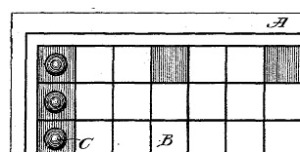
So, I’m reading A Gamut of Games (Sid Sackson), and it mentions in passing that thousands of board games were patented in the late 1800’s and early 1900’s.
And child-of-the-80’s Neal’s subconscious pipes up with, “too bad; it would cost a mint to track through all that microfilm to find the good stuff.”
Waitaminute! The internets! Is there a way to find expired game patents from 100 years ago? Why, yes, and its URL is:
http://www.google.com/advanced_patent_search
As Mr Sackson noted, many of these games stink, are racist, or are about baseball. Also, these are legal documents, so making the rules clear is not their primary goal.
Gamut includes “Blue and Grey”, a nice checkers variant, that Mr. Sackson found in a patent search, in the seventies. He lived in NYC, so he had access to the patent library via the public library there. They were probably on microfilm reels– here’s the process: look through the (30-pound book of) title lists and keywords, jotting down reel reference numbers, then check out (one at a time) reels with possible matches, then use a Xerox kinda thing to get prints of good ones ($.15 a page), then go home and figure out that they’re all crappy games– repeat twice a week for your whole life, get 20 games.
The graphic from this post is from a 1902 patent awarded to L. B. Gaylor.
The age of original documents is upon us. When I was in school, you acquired expertise in an area by finding books that anthologized the best books in the field. Usually, the books you found did a their jobs poorly, or only in service to the editor’s agenda, or were limited by the editors’ own poor document access.
Now, most original documents are available to everyone with a computer. That’s not everyone, but it’s a billion more than it was. Usually, it’s via Google, and that will eventually be a problem.
Gamut also mentions the Young Folks’ Cyclopaedia of Games and Sports, a long-out-of-print treasure trove of games and rules– again, at the time, available only to book collectors or scholars with crazy library privileges. Here’s the link to the PDF:
http://books.google.com/books?id=sysqAAAAYAAJ&printsec=frontcover&dq=Young+Folks+Cyclopaedia+of+Games&cd=1#v=onepage&q=Young%20Folks%20Cyclopaedia%20of%20Games&f=false
This book, and all these patents, and all their games, belong to everyone– they are in the public domain. All we need to do is find them.
I intend to find a lot of them.
(Microfilm? Really, subconscious? When did we become a geezer?)


